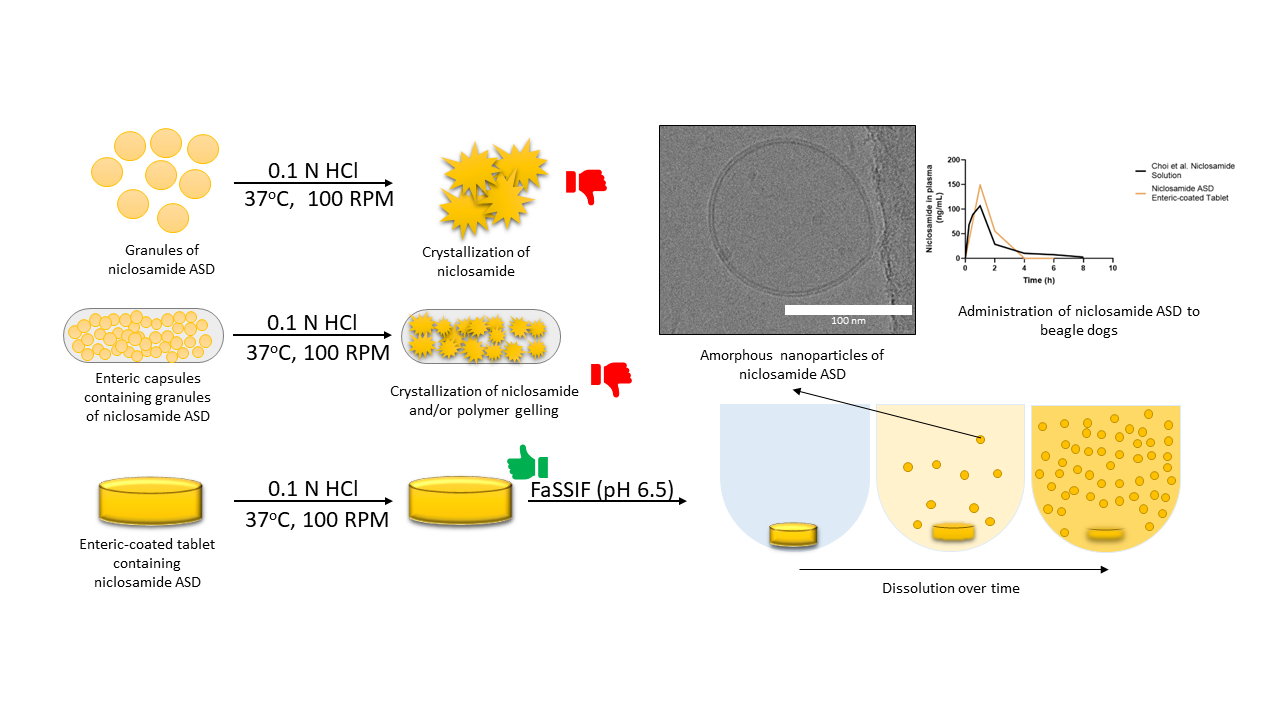Oral Delivery of Niclosamide as an Amorphous Solid Dispersion That Generates Amorphous Nanoparticles during Dissolution

Niclosamide is an FDA-approved anthelmintic that is being studied in clinical trials as a chemotherapeutic and broad-spectrum antiviral. Additionally, several other applications are currently in the preclinical stage. Unfortunately, niclosamide is a poorly water soluble molecule, with reduced oral bioavailability, which hinders its use for new indications. Moreover, niclosamide is a poor glass former; in other words, the molecule has a high tendency to recrystallize, and it is virtually impossible to generate a stable amorphous solid employing the neat molecule.
Previously, our group reported the development of an amorphous solid dispersion (ASD) of niclosamide (niclosamide ASD) that generates nanoparticles during its dissolution, not only increasing niclosamide’s apparent solubility from 6.6 ± 0.4 to 481.7 ± 22.2 µg/mL in fasted state simulated intestinal fluid (FaSSIF) but also its oral bioavailability 2.6-fold in Sprague–Dawley rats after being administered as a suspension. Nevertheless, niclosamide ASD undergoes recrystallization in acidic media, and an enteric oral dosage form is needed for its translation into the clinic. In this work, we further characterized the nanoparticles that generated during the dissolution of the niclosamide ASD.
Cryogenic transmission electron microscopy (Cryo-TEM) and wide-angle X-ray scattering (WAXS) revealed that the nanoparticles were amorphous and had a particle size of ~150 nm. The oral dosage forms of niclosamide ASD were formulated using commercial enteric capsules (Capsuline® and EudracapTM) and as enteric-coated tablets. The enteric dosage forms were tested using pH-shift dissolution and acid-uptake tests, using the USP type II dissolution apparatus and the disintegration apparatus, respectively. The capsules exhibited a higher percentage of weight gain, and visual rupture of the Capsuline capsules was observed.
Eudracap capsules protected the formulation from the acidic media, but polymer gelling and the formation of a nondispersible plug were noted during dissolution testing. In contrast, enteric-coated tablets protected the formulation from acid ingress and maintained the performance of niclosamide ASD granules during dissolution in FaSSIF media. These enteric-coated tablets were administered to beagle dogs at a niclosamide dose of 75 mg/kg, resulting in plasma concentrations of niclosamide higher than those reported in the literature using solubilized niclosamide at a higher dose (i.e., 100 mg/kg).
In summary, an enteric oral dosage form of niclosamide ASD was formulated without hindering the generation of nanoparticles while maintaining the increase in the niclosamide’s apparent solubility. The enteric-coated tablets successfully increased the niclosamide plasma levels in dogs when compared to a niclosamide solution prepared using organic solvents.
Download the full article as PDF here Oral Delivery of Niclosamide as an Amorphous Solid Dispersion That Generates Amorphous Nanoparticles during Dissolution
or read it here
Materials
Niclosamide anhydrate was purchased from Shenzhen Nexconn Pharmatechs LTD (Shenzhen, China); Kollidon® VA64 (PVP–VA) and Kolliphor® TPGS (D-ɑ-tocopheryl polyethylene glycol succinate, TPGS) were obtained from BASF Corporation (Tarrytown, NY, USA). Niclosamide, PVP-VA, and TPGS were admixed at a 60:35:5 ratio and extruded using a ZSE 12 HP-PH (Leistritz Advanced Technologies Corp., Nuremberg, Germany). The extrusion was performed at a feed rate of 3 g/min with a screw speed of 50 rpm. The operating temperatures are specified in the Supplemental Information, Table S1. Then, granules of niclosamide ASD were obtained by milling the extrudates using a Fitzmill Comminutor Model L1A Benchtop Mill (The Fitzpatrick Company, Westwood, MA, USA) operating at 5000 rpm and equipped with a 0.06″ round hole screen.
Jara, M.O.; Warnken, Z.N.; Sahakijpijarn, S.; Thakkar, R.; Kulkarni, V.R.; Christensen, D.J.; Koleng, J.J.; Williams, R.O., III. Oral Delivery of Niclosamide as an Amorphous Solid Dispersion That Generates Amorphous Nanoparticles during Dissolution. Pharmaceutics 2022, 14, 2568. https://doi.org/10.3390/pharmaceutics14122568

